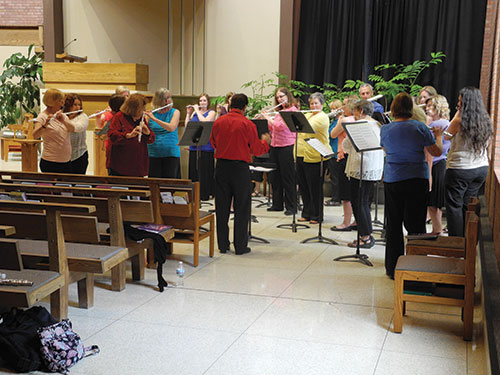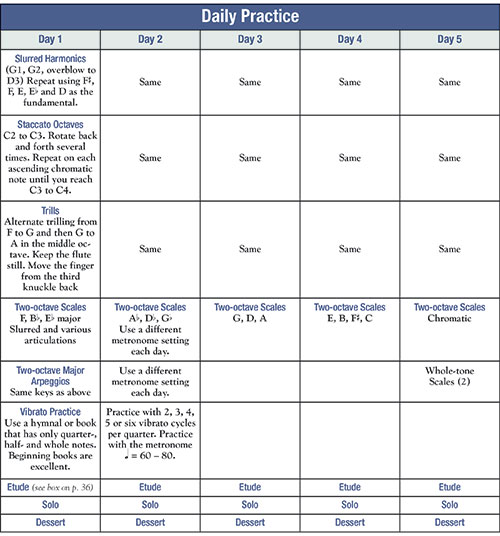One of the things I enjoy most about coaching an adult flute choir is the diversity of its membership. While the Fox City Flute Choir’s membership has a few adults with music degrees, most of the others played in college while majoring in other disciplines. In addition to the music majors, we currently have a realtor, a librarian, a family practice doctor, a retired telephone company executive, a stockbroker and a couple of CPAs. Besides playing in the flute choir, members also perform in a regional symphonic band, a local symphony and in church music programs. Sometimes they attend the Wisconsin Flute Fair or the annual NFA convention. They all share a love of the flute and a desire to play better.
Once a week we rehearse for one of the five to seven concerts we perform per year. Each rehearsal begins with everyone playing a C flute in unison. During the 20- to 30-minute warmup, we work on harmonics, top-octave fingerings, scales with varying articulation patterns and dynamics, arpeggios, seventh chords, vibrato studies, trills etc. Sometimes we study a melody together and analyze where the phrases are, what the phrase shapes are, what notes to emphasize, where to breathe, vibrato speed, dynamics and so forth – much like a flutist would do in private practice using Marcel Moyse’s 24 Little Melodic Studies. Sometimes we talk about a special playing technique such as slightly lengthening the note before a slurred leap of a fourth or more. I have always felt that if each player interpreted notation the same way, the ensemble would play on a higher level. Working with these dedicated flutists lets me try new things each week and has contributed immensely to my research into pedagogy.
The one question that everyone eventually asks me is “Most days, I have only a little practice time, what do I practice so that I get better?” Actually, this question plagues all musicians – how do you get excellent results with little practice time?

Time to Practice
A regularly set practice time will help you remember to practice. This might be first thing in the morning or the last thing at night. It could even be during coffee breaks or stolen time from the lunch hour. One of my adult students once informed me that she could warm up on the headjoint while driving to work. To begin with, carve out 25 minutes of time when you can use your best concentration skills. As you hear your successes, you may want to add more time. Aim for practicing five days a week. You will be proud of yourself if you do more.
Location
Find a place to practice where you will not be bothered. Turn off your phone. This is your time so get the most out of it. Be sure you have a good chair, a sturdy music stand, a metronome, tuner, practice materials, and note-taking supplies.
Make a Plan
Analyze your playing by recording a favorite piece and then critically listening to the playback. Make long-term and short-term goals. A long-term goal might be to play a movement or two of the John Rutter Suite Antique at church. A short-term goal could be to learn the sharp scales, two-octaves in sixteenth notes with quarter note = 104 or to get better control of your vibrato.
At the beginning of each week write down your goals and create a practice plan. At the end of the week, record several snippets from your practice on your phone and assess how you have done in reaching your goal. Based on what you hear, make a new plan for the next week.
Before You Begin
Have your flute checked over so it is in its best playing condition. Align the flute the same exact way each day. Use a felt marker to place a line on the headjoint and body to make lining them up easy. A mirror or a video recording on your phone can be used to check posture. Check the position of your feet (if standing), and the placement of your head, hands, and arms. Practicing with a good setup means you will not get injured and can achieve better results.
Practice Routine
Since each player has strengths and weaknesses, this is a generic practice routine. If something is difficult for you, rather than practicing it on just one day, play it for a week or a month. It is more important to make true progress, and not just turn the page and go on to the next exercise like you would in elementary school. Remember that some etudes are not as good as others, so do not be afraid to skip one or learn them out of order. An etude book should serve you, and you certainly do not need to be a prisoner to it.

Reward
At the end of your practice, there should always be a piece of music on the music stand that you love to play. For me it might be one of the Karg-Elert Caprices, the Telemann Twelve Fantasias, Borne’s Carmen Fantaisie, Gaubert’s Fantasie, or one of the Romantic theme and variations by Tulou, Boehm, Demersseman, or Taffanel. This piece is the dessert for your practice time. Use this time to think about why you love to play the flute so much.
One final note, if you are not already a member of a flute choir or local band, join one. The more you play and perform, the more you will want to practice.
Suggested Etude Books
Berbiguier: 18 Exercises
Hugues: 40 Studies, Op. 101, Op. 75
Andersen: Op. 41, 33, 30, 63, 15
Altes: 26 Studies
Boehm: 24 Caprices
Karg-Elert: 30 Caprices
Furstenau: Op. 107, Vol. 1 and 2
Kohler, Op. 75, Op. 33
Casterede: Twelve Studies for Flute
Many of these books may be downloaded for free at www.imslp.org






